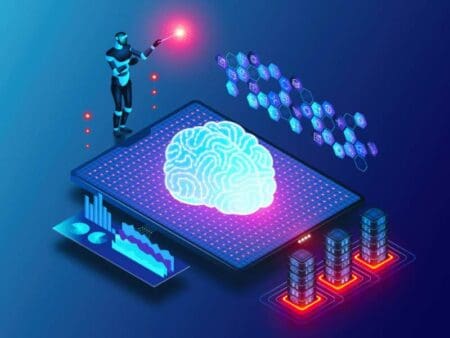
The benefit of DALL-E 2 and ChatGPT-4’s explosion is that it demystifies the myth of AI as an “in-30-years” solution. The time is now to capitalise upon generative AI, hybrid AI and explainable AI to solve the great crisis of this generation: saving the crumbling environment.
By AJ Abdallat, Beyond Limits CEO
The Biden administration recently passed a green infrastructure bill that allocates $250 million to energy and water conservation efforts to lessen emissions from government facilities. The President earlier declared his intentions to make the US government a net zero entity by 2045 with a combination of a zero-emission vehicle fleet and net-zero emission building portfolio.
To expand this goal to the entire country – and globally – there are various key improvements that must occur.
Here are four key ways that AI can bring dreams of net zero into clearer focus:
- Strengthen the grid
- Modernise the oil and gas industry
- Decarbonise the atmosphere
- Drive accessibility of electric vehicles
1. Strengthen the grid
It doesn’t take a “Storm of the Century” to down the grid, leave thousands in the dark and put human safety at risk. It’s unlikely to be a coincidence that as global warming intensifies these weather anomalies increase in number and strength. The Texas ice storm of 2021 and the United Kingdom’s heatwave in 2022 are prime recent examples of the grid’s failings.
Currently, utility operators depend upon predictions to estimate the next day’s draw on the grid. They consider the weather forecast, potential surges and lulls in business activities. Accurate predictions are essential to ensuring there’s enough power for everyone. Under the mountain of historical data points and past predictions lie patterns. Utility companies can shore up the grid by employing AI to assist in pattern detection and determine next steps based on the patterns. A strong grid is a resilient one. Utilities can strengthen grid performance by utilising these AI-discovered patterns to prepare for the next day’s energy draw and to make real-time pivots to evolving demands.
Accurate predictions contribute to more efficient and carbon-conscious operations. The better the predictions, the less utilities companies have to generate excess power. The boon to the utilities is that generating and delivering the right amount of energy at the right time lowers their operational costs. The benefit to the environment is more conscious energy creation and less waste.
Have you read:
Smart meter data to power new AI platform in ‘Middle East first’
How generative AI is coming to the energy sector
AI and robotics research is being spurred through a solar ‘living lab’
2. Modernise the oil and gas industry
Renewable energy sources aren’t yet able to sustain every power need, thus it’s worth the energy and investment to modernise the oil and gas industry. Additional infrastructure like sensors and tracking programmes are likely needed to make the industry as environment-friendly as it can be.
AI can assist in detecting breakdowns in equipment and signaling to maintenance where repairs are necessary. This system could help oil and gas machinery components last longer, instead of breaking down completely and being tossed on the top of a landfill.
Supply and demand tracking can also benefit from an AI boost. For example, an AI-assisted tracking system of the supply chain can identify bottlenecks in production or delivery. From there, oil and gas companies can smooth inefficiencies, thus avoiding overproduction – which is detrimental to the environment – or underdelivery that then puts a strain on other resources.
3. Decarbonise the atmosphere
While humans can do nothing to repair the hole in the ozone layer, carbon capture contraptions can slow the deterioration of this essential atmospheric protective casing. New materials discovery is a long, expensive and often fruitless exercise, which is bad news for quick discoveries that can make a difference to the environment.
Explainable AI here will be especially helpful. Instead of “black box” AI solutions that spit out an answer, explainable AI always shows how it arrived at its result. This way, if the explainable AI’s result was incorrect, engineers can at least inspect the AI’s reasoning and glean knowledge from its path. The “glass box” of explainable AI makes it a helpful partner to a human team tasked with thinking creativly for new solutions.
AI can also speed up the trial and error process of new materials discovery key to decarbonising the atmosphere. For instance, instead of scientists wasting precious time manually going through each slight computation only for it to end in failure, they can entrust AI to run through the scenario and only raise a flag when a solution looks promising.
Also of interest:
You’ve got mail… from the next generation
E-mobility deployment and its impact on European transmission and distribution grids
4. Drive accessibility of electric vehicles
The issue today with EVs is that they’re much too expensive for the average household. Before taxes and fees, the least costly Tesla model has a price tag of about $42,000. Paying that much for a car would take up approximately 60% of the average American’s yearly salary, which, in 2021, was south of $70,000. The culprit for EVs’ high price is the battery.
Automakers are continually improving EV battery range; but, just like new materials discovery, the time-intensive and expensive trial and error phase usually ends in error. Development costs skyrocket with each successive day. Considering that Lithium-Ion batteries took two decades to perfect, there’s likely still a long way to go before engineers perfect EV battery performance at a reasonable cost to consumers.
The semiconductor shortage of 2020 certainly doesn’t help in the high cost of EVs, so automakers must strive for alternatives. Again, AI can assist in speeding up the trial and error process and assist engineers in developing creative lines of thought to improve EV production and roll out a model accessible to the average family. The more fossil-fueled vehicles EVs can replace on the roads, the cleaner the air will eventually become.
Resiliency, modernity, discovery: AI at the centre of it all
While the digital art world grapples with the legitimacy of DALL-E creations and high school teachers everywhere lament the proliferation of ChatGPT-written essays, the overall impact of these and similar applications is positive. The barrier to adopting AI is now lowered.
AI in the utilities and materials discovery fields isn’t a brand new concept, but trusting AI to do more than sort data is. Hybrid AI especially is now more of a partner in creativity, “thinking” up new ways to solve a problem while speeding up the problem solving process. Environmental and energy leaders must continue to hone AI’s capabilities to achieve a net zero society. Governments around the world, including the Biden administration, are handing over the funds. Now, brilliant minds must turn those funds into action and a greener future.
ABOUT THE AUTHOR

AJ Abdallat is CEO of Beyond Limits, an artificial intelligence engineering company creating advanced software solutions for the energy, utilities and healthcare industries, and is on the advisory board for Caltech’s Center for Autonomous Systems and Technologies (CAST).
With a master of science in engineering from the University of Missouri, Abdallat has over 20 years’ experience building high-tech startups in the fields of bio-inspired artificial intelligence, reasoning systems and smart sensors.








